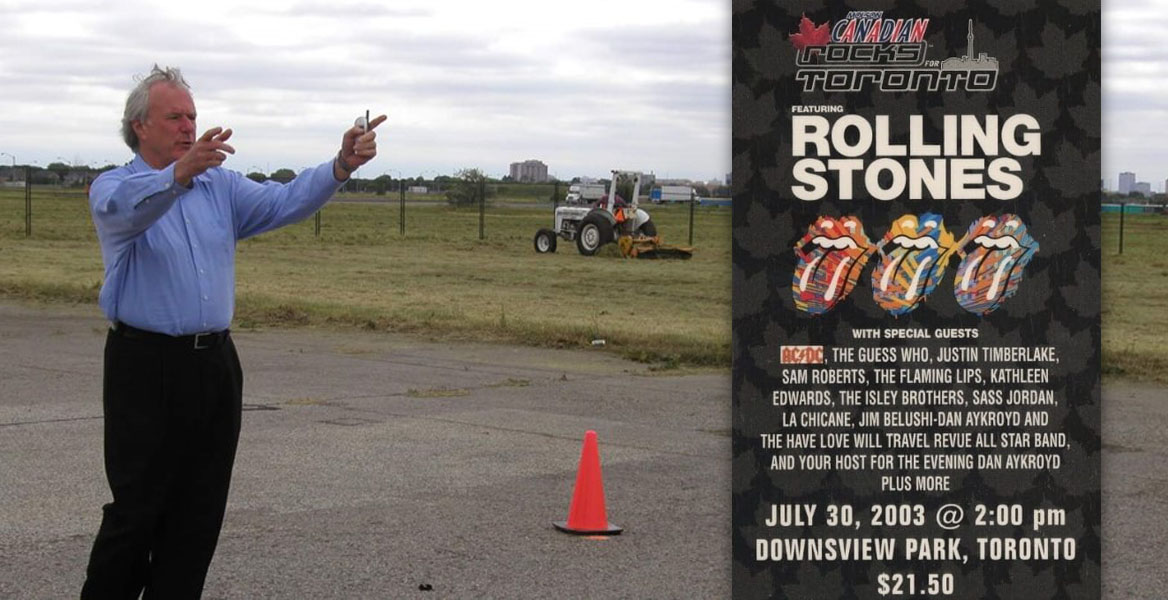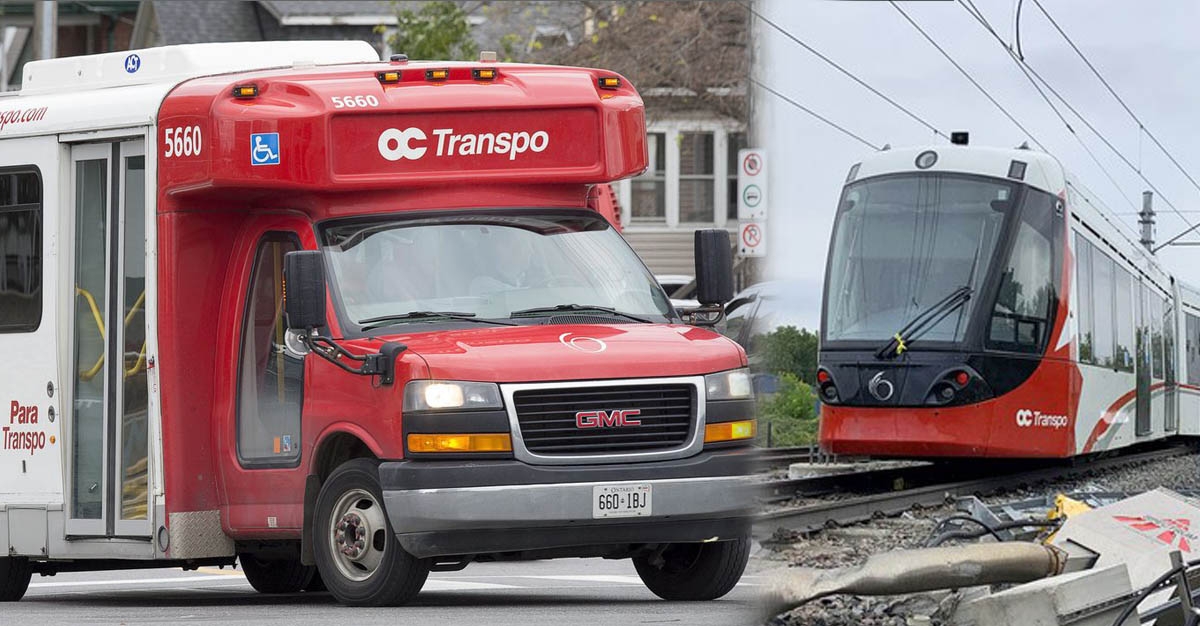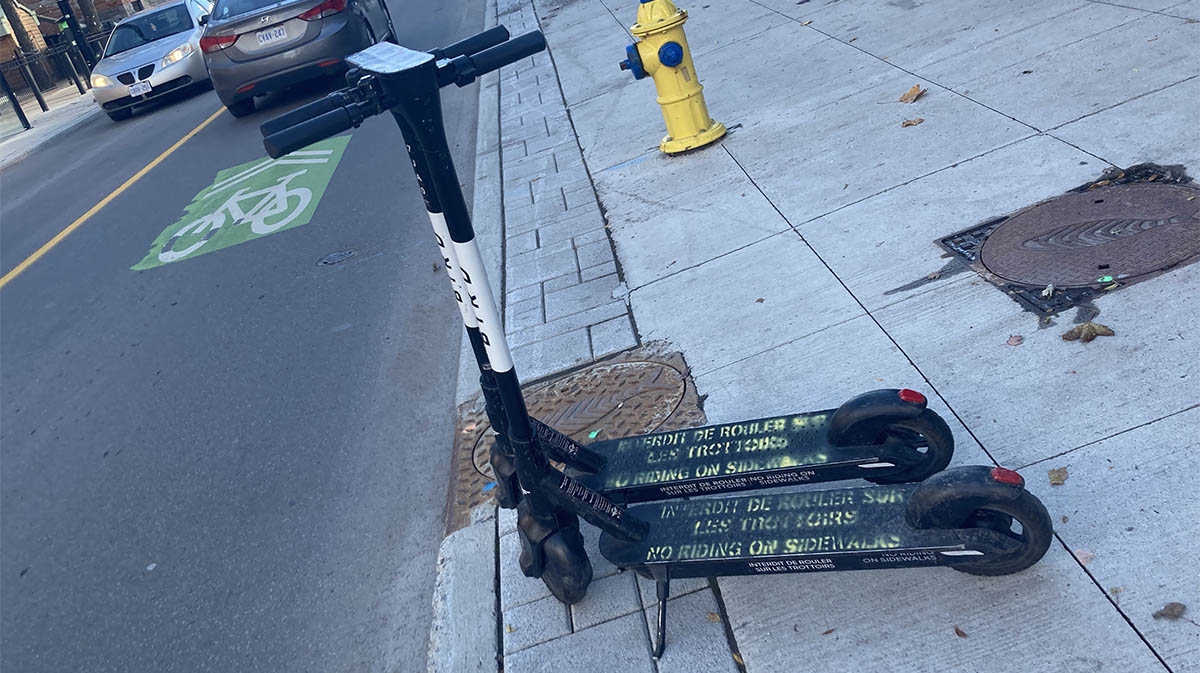
SARSTOCK 2003: The Untold Story of Molson Canadian Rocks for Toronto
ABOVE: Then Toronto-Danforth MP Dennis Mills — a self-propelled tour de force (pictured in 2003) organised Canada’s largest concert ever to help Toronto recover from SARS. (Photo: Angelo Persichilli)
By Dennis Mills
It was the spring of 2003, typically a season of re-growth, colour and beauty. Yet, Toronto—its businesses and its economy—was on a collision course with economic pain: The city was put on a health advisory by the World Health Organization, which told the world, “do not travel to Toronto.” The effects of SARS were emptying our hotels, convention centres, bars, restaurants and pretty much anything else that lured tourists to the city during the spring and summer months.
I was asked by my caucus colleagues to participate in a business community meeting in Toronto. The community I represented as a member of Parliament, Toronto-Danforth, featured a dozen or so neighbourhoods that boasted many of the city’s best eateries and social spots. Imagine the rippling anxiety we felt as we headed into the spring/summer season, which is when our community makes most of its money—and all of a sudden, you’re totally shut down.
After a week of meetings, a plan was presented, one that outlined how we could reach out to different parts of the world and promote travelling to Canada. The problem for me was that the plan was generally geared for the following year, 2004. So, I chimed in and said, “We have to do something right now. I have a lot of people in my community who won’t even see the fall, never mind next year.” I knew I had to get something going faster and so I told them I was going to try something different.
I headed for the offices of Michael Cohl, the manager of the Rolling Stones, and one of Canada’s greatest music promoters. He and I shared an association that went back to when Chair-man Mills did the staging and supplied chairs for some of Michael’s early concerts.
This was my pitch: “Look, the city has been good to both of us. Here’s my idea: you have the Stones, and I think I can deliver the government. The Stones have a global reach. Why not do a massive concert? We could stage it either at the waterfront or at Downsview, which is where we hosted much of World Youth Day in 2002.”
Michael replied: “Ok, I like it. I like the idea. But the boys are on tour.” The Rolling Stones were working, performing overseas. Michael then offered, “I’ll talk to them tonight. Let me see what I can do, and I’ll get back to you tomorrow.”
The following morning, I received a letter via fax, which confirmed that the Rolling Stones agreed to do a show in Toronto in the last week of July, and the cost would be roughly $13 million for the entire event. The Rolling Stones were prepared to reorganize their tour, come to Toronto, and do something big.
I had an idea about the next step. I called Michael and said, “Look, I need to leak this letter to the media.” He was uneasy. “Ok,” he said, “but I have to tell you that I feel very uncomfortable about that. Having said that, I trust you.” I explained that I needed to rally the community around this idea, and it had to be done quickly.
The next step centred on Mike Duffy, the CTV National affairs bureau chief in Ottawa. “Mike, I have in my hands a commitment here from the manager of the Rolling Stones. The letter confirms that they will do a massive event to help promote Toronto get back into business.” I continued: “I need some help in getting the message out to see if the community will rally around this.” Mike asked me, “You have the faxed copy of the letter in your hands?” Before I finished reading the last line, Mike said to me, “I’ll have a camera and a crew at your Danforth office in 15 minutes.” Fifteen minutes a CTV crew was on-site in our constituency office, and the interview proceeded. Mike’s story for CTV became the lead story on national television that night.
The next 24 hours were unlike any I had ever experienced. A series of events took place that I wouldn’t wish on anyone. As Mike’s CTV story went viral, commentators, journalists, talk show hosts and call-in guests absolutely blasted me. I was criticized, even ostracized, by what seemed to be a growing mass of people who thought I had lost my mind: “Who is this idiot MP who wants to use taxpayer money to give the Rolling Stones $10 million?” The $10 million figure was the number quoted in the original and subsequent stories over the airwaves. I had colleagues in the Liberal caucus who called me saying, “Dennis, have you lost it? You’re going to cost me my seat.” Their calls to me were in response to feedback from their constituents, people who were demanding to know who the guy was who wanted to give Mick Jagger taxpayer money. That was the focus. It wasn’t on the 250,000 businesses that were failing because of SARS and the health/travel advisory that the World Health Organization had slapped on Toronto. The how-dare-you focus landed clearly on me. I had no friends in the caucus at that time. I was alone.
So, the following morning I was booked on CFRB 1010 Toronto. Everybody wanted to hear from the “guy” with the outrageous idea. Somewhere near the middle of the program I offered, “Ok, what if we got the private sector to pay for the artists and we use the government to pay for the infrastructure, things like security, staging or washrooms?” Suddenly, the interviewer looked directly at me and said, “With that I have no problem. Use the government to do all those things, but no taxpayer money goes to the artists.” I then explained the caveat: “Well, then we need to find a sponsor, because 50 percent of the $10 million will be for the entertainment.” Suddenly the tide shifted, and people were saying, “As long as we don’t use taxpayer money to pay for the artists, this is a very good idea.” So that became the message for the rest of that second day.
Later that evening, I received a call from a gentleman by the name of Jonathon Vrozos, who owned the Peel Pub on King Street West, adjacent to the Prince of Wales Theatre. Jonathon told me that a bus of people would be visiting the neighbourhood around his pub the following night. He said, “Tomorrow night, the President of Molson, Dan O’Neill, is coming on a bus with all sorts of hockey players, actors and Olympic athletes. They are going to visit all the bars, pubs, and eateries and hopefully inspire people to get out and visit the bars.” I thanked Jonathon for the tip, and I let him know that I would be there.
Around that same time, my friend, Senator Jerry Grafstein, reached out to me. We were already moving along the path that stipulated “no taxpayer money for the artists,” so we were scouting out who might step up with private sponsorship. Jerry and I headed over to the Peel Pub, and we sat in the corner. Shortly thereafter, the bus arrived. Dan entered the Pub. He saw me and almost immediately said, “Dennis, I am not giving you $10 million. No way.” Taking Dan’s lead on the topic of our conversation, I tried to reassure him: “Dan, I don’t need $10 million; I only need $5 million.”
He looked at me with an expression of incredulity. I said, “Dan, any time we have ever done anything together, you guys have always done well. So, think about it.” As Jerry and I were leaving, we walked by Dan, and I said to him, “I want to be straight up with you: you’ve got to tell me by tomorrow morning because if you guys aren’t interested, I’ll have to go across the street. I would need to go to somebody else.”
The following morning, I received a call from Dan O’Neill. Right to the point, he told me, “We’re in.” And that phone call from the late Dan O’Neill was the trigger that made the entire effort move forward.
I then had to get Prime Minister Chrétien onside. We needed to confirm infrastructure support by the Government of Canada. After a brief discussion, the prime minister said, “Look, Dennis, we’re not going to get behind this unless the Chief of Police [who at that time was Julian Fantino] says that he is onside. I want no part of it unless Fantino is in.”
The next morning, I called Chief Fantino. I met him the next day and briefed him on the status of things, specifically about Molson’s commitment and the prime minister’s insistence that the Toronto Police Service commit as a partner. I said, “The prime minister’s commitment is contingent on your agreement to make sure the whole idea has proper security.” Chief Fantino replied, “You know, Dennis, I was just in Rome, and I saw Paul McCartney give a concert to upwards of 400,000 people, and there was no problem.” He asked me what I needed. I explained to the chief that we needed a letter with his signature, saying that he was totally behind the project. He immediately called his assistant to transcribe his letter, and I walked out of his office. I informed my colleagues in Ottawa that I had the letter in my hands, and we were ready to move forward and serve our city, our hundreds of thousands of small businesses, and the larger national economy that shares in its success.
And from that point on, Senator Jerry Grafstein and I were partners in the journey.
We moved to the next step: location. We first looked at the waterfront, specifically the Portlands. We reached out to the folks at Waterfront Toronto. The site was not big enough.
Our next option was to explore Parc Downsview Park. Of course, we had a great precedent there because we organized World Youth Day and received Pope John Paul II at that location the year prior. We had worked beautifully with Tony Genco, who ran Parc Downsview Park.
The concern at the Downsview site had to do with a previous sewage flood: someone didn’t correctly address the septic issues during World Youth Day. Despite that mishap from 2002, Gerrit de Boer, the owner and founder of Idomo was totally fine with the idea of the project.
Among the many stories from those weeks, I have very special memories of Senator Jerry Grafstein. On more than a few occasions, our efforts relied on luck. For example, we were fortunate to enjoy the goodwill of all three levels of government, including our colleagues in the Ontario government, through the leadership and support of Premier Ernie Eves and Health Minister Tony Clement. But one of the great stories had to do with a bit of ingenuity and luck that Jerry and I somehow tapped into.
Both he and I had the idea that we wanted to promote this event to every possible location, on and off planet, to as many viewers as we could conceive. We had organized through CBC that the video feed of the event would reach Canadian military personnel everywhere. The piece we still hadn’t addressed was how to reach the US military bases around the world.
Thanks to Barry Appleton, a Canadian powerhouse in international trade law, I had the good fortune to become acquainted with Tom Donohue, then President of the US Chamber of Commerce in Washington, DC. I called Tom and explained what we were working on. He was enthused: “Super! What can I do?” So, I explained to him, “I need the phone number for the Secretary of Defense.” He said, “Let’s see. Oh yes, here it is.” He gave me the number. What a stroke of luck! I then turned to Jerry and said, “Jerry, you’ve got to make this call because the word MP, even member of Parliament, doesn’t mean anything throughout the landscape of US government. But for you … Senator Grafstein … I think that will cause a reaction.”
Jerry got on the phone and managed to speak with the chief of staff to the US defense secretary. I was able to hear the person talking: “Yes, Senator. What can I do for you, Senator?” To this day, I still maintain that the chief of staff, this person we were talking to, didn’t realize that Jerry was a Canadian official.
Jerry told the chief of staff on the other end of the line that we were preparing a massive event in Canada. Jerry explained, “We would like to send a signal to all of your international stations worldwide—all of your personnel.” The chief of staff said, “Senator, leave this with me. I’ll see what I can do. Give me twenty minutes.” And I swear: he called back in 20 minutes. Again, I could hear his end of the conversation through the receiver. He said, “Senator, I have guaranteed the secure United States defense satellite. This will transmit the signal to our land bases in 97 countries. We’ll also send it to our 182 ships at sea.” And he then added, “And we’ll also send it up to the Space Station.” Jerry and I looked at each other. We would be everywhere, both on- and off-planet.
The event featured truly special gems as well. We had the mile-long beef BBQ that Shane Carmichael ran so brilliantly. We worked with Alberta famers and representatives of the province’s beef industry, and he tapped into the spirit of the day by coordinating the participation of four provincial premiers—Premier Ernie Eves of Ontario; Premier Ralph Klein of Alberta; Premier Lorne Calvert from Saskatchewan; and Premier Gary Doer from Manitoba—each of whom had a great time tending the BBQ and serving fans.
We had the March of Dimes’ accessibility section, the largest of its kind for fans with disabilities, which Paul Raina and Steven Christianson orchestrated. We built the first-of-its-kind, largest-ever viewing platform to accommodate more than 2,000 fans with disabilities, an estimated 700 of which were in wheelchairs.
That special section set the standard for inclusion of people with disabilities. It featured a designated area which had special facilities for three fans who required dialysis treatment, a wheelchair technician, and an onsite veterinarian for the few dozen seeing-eye dogs.
But the one that tops it off for me circles back to Michael Cohl.
AC/DC was the second last act, and they were at the point of finishing their set. Someone from the CBC operation approached me and said, “Dennis, Peter Mansbridge would like to do a wrap-up interview with you from the top of the CBC tower.”
The event featured an incredible lineup of performers who were there to help reinforce the message about Toronto’s safety. MCs Dan Aykroyd and James Belushi got things rolling, followed by Sam Roberts, Kathleen Edwards, La Chicane, The Tea Party, The Flaming Lips, Sass Jordan, The Isley Brothers, Blue Rodeo, Justin Timberlake, The Guess Who, Rush, AC/DC, and the Rolling Stones. But it was the Rolling Stones, as the feature performance, which clearly cemented the event’s attraction to the masses of people. Without the Stones, there never would have been a Molson Canadian Rocks for Toronto as we know it. And the sheer genius of Michel Cohl in producing such a varied line-up of talent to complement the global reach of the Rolling Stones was truly inspiring.
Here we are, 20 years later, and people still remember the positive vibe from that day and from that event. The aim was to put Toronto back on the world map. I like to think that the collaboration from everyone, over a matter of ten weeks, was an example of the expression, “when there is a will, there is a way.”
At the end of the day that event was meant to reflect our entire community, everything that Toronto is and has to offer. And to help give the world a glimpse into Molson Canadian Rocks for Toronto, Michael Cohl and the Rolling Stones decided that the Canadian Broadcasting Corporation should produce the show. Riley O’Connor, now the Chairman of Live Nation, Canada’s leading concert promoter, served as the event’s chief operating officer. Both he and Stephen Howard helped put the production over the top. Jo-Ann McArthur, the lead public relations executive on behalf of Molson’s, was masterful in her craft throughout the entire production end of the event. And working eighteen hours a day, handling every small detail and logistic, was Bob Singleton, the greatest concert hands-on organizer of all time, who handled details on behalf of Molson.
SARSFEST, or SARSTOCK if you prefer, ended up being so much more than we could have imagined when we first announced the idea ten weeks earlier. So many aspects took on a life of their own.
The goodwill on the part of so many people took on a life of its own, snowballing and gaining its own momentum.
So, for me and so many others, Molson Canadian Rocks for Toronto was about service, cooperation and goodwill for a greater cause. People—everyone—joined together to help people. It became a model of collaboration: a harmony of three levels of government; the enthusiastic participation of Toronto’s Police Service; the dedication of service from the TTC and TTC WheelTrans; and the magical talent of every artist on that stage. Twenty years later, I reflect on these untold stories (and there are many more), of people and organizations which exemplified selflessness; and each reminds me of what can be achieved in just about any challenge or big project.
Footage of the Rolling Stone live at Molson Canadian Rocks for Toronto(2003). (Video: Courtesy RollingStones50years5)
This is an edited excerpt from Big Sky Publishing of Toronto’s upcoming memoir by Dennis Mills The Life of a Servant: From the Wood Chair to the Green Chair.








